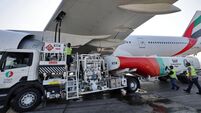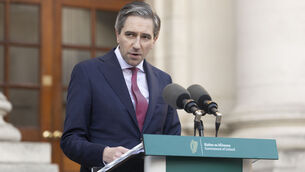Ireland and Apple is a relationship that goes beyond mere tax advantages

'Much is made of Apple’s tax arrangements in Ireland. The structure that was subject to a state-aid investigation by the European Commission had been in place since Apple came to Cork in 1980.'
Apple was founded in 1976 in Steve Job’s bedroom of his parents’ Californian home. Just four years later the company’s revenues exceeded $100 million and it sought to establish its first international location. That location was Hollyhill in Cork.
Initially, Apple’s Cork facility was primarily a manufacturing facility. It is now the only manufacturing facility owned directly by the company as pretty much all the company’s manufacturing has been outsourced.
For its iPhone and iPad products, Apple buys components from third-party suppliers and has the products assembled, mainly by companies in China. But back in the 1980s, Apple did most it of its own manufacturing. For a short time, Apple had a factory in Millstreet that produced keyboards for Apple computers but this was closed in 1985 with the loss of 200 jobs.
With IBM-compatible PCs becoming dominant Apple went into decline in the 1990s and there was a time when many felt it would fall into bankruptcy. However, the return of founder Steve Jobs reinvigorated the company and so too the fortunes of its Cork operations.

For Apple’s second coming, Cork became a much more services focused facility. Yes, it continues to produce bespoke iMacs tailored to a customer’s preferred specification but the bulk of the 6,000 staff are in services. These include in-house services such as logistics and supply-chain management and customer-facing services such as support and invoicing.
Much is made of Apple’s tax arrangements in Ireland. The structure that was subject to a state-aid investigation by the European Commission had been in place since Apple came to Cork in 1980.
Initially, the amount of Apple’s profit to be taxed in Ireland was of little interest to the Revenue Commissioners as Apple was eligible for the Export Profits Sales Relief. This meant the effective tax rate on profits made from exports from Ireland was zero.
This relief was abolished and by 1991 Apple was subject to a 10 per cent rate of Corporation Tax for manufacturing. Now the Revenue Commissioners took an interest Apple's profit and through discussions with the company set out to agree a formula to determine the amount of profit that would be taxed at that 10 per cent in Ireland.
It is the outcome of these discussions and the subsequent taxation of other Apple profits that was central to the Commission’s state-aid investigation. The Commission argued that all the profit Apple earned on the sales of its products outside the Americas should be taxed in Ireland. This was thrown out by the Court of Justice of the European Union though the Commission has appealed this judgement.
Apple is a hugely successful company and some of the numbers involved are staggering. The near-bankruptcy of the 1990s is a distant memory.
In the past ten years, Apple’s revenues have been around $2 trillion or $2,000 billion. Of this, around $1,200 billion has gone to component providers, third-party manufacturers and other suppliers.
Over the decade, Apple’s in-house costs were around $200 billion with significant expenditure on R&D, sales, marketing, and general administrative expenses. Employee wages would have made up a large share of these costs.
All told that left a profit before tax of $600 billion in just ten years. Excluding state-owned oil companies, no company has ever earned profits of this scale.
And Apple also pays taxes on a massive scale. Over the same ten years, Apple made just over $100 billion of cash payments for corporate taxes to governments around the world. This means that the company paid around 17 per cent of its profits to governments in tax.
One issue with this is that most of it was paid to the US Treasury. This isn’t a surprise as most of the risks and functions that make Apple profitable take place in the US so most of its profit should be taxed there.

Yes, Apple sells tens of billions worth of products and services to customers around the world. However, selling phones in a shop isn’t a very profitable activity as the frequent insolvencies of consumer electronics retailers will attest to. Designing a phone that people want to buy is very profitable and the Apple activity behind that takes place in the US. That is why most of Apple’s profit is subject to tax in the US.
However, the company does not want to limit its activities to the US. Like many US companies who wants an overseas presence, it has chosen to organise it out of Ireland. At the time of the high-profile US Senate investigation in 2012 into its tax affairs, Apple had around 2,500 employees in Cork.
At the depths of the last recession, there was only one location in Cork city with tower cranes and that was Hollyhill. Roads were rerouted to accommodate Apple’s expansion with the city boundary essentially being pushed into the county even before the formal expansion of the city in 2019.
It might be despite or even because of the scrutiny on its tax affairs here but Apple now has 6,000 direct employees in Cork. Its presence also leads to indirect employment in professional services, security, catering and transport such as taxis. Indeed, some Irish suppliers that started out in with Apple in Cork have gone on to become global suppliers as the company has expanded.
The contribution of US companies to the Irish economy is immense. Each year, they pay around €8 billion to their 100,000 or so direct employees. They buy around €4 billion of goods and services from Irish suppliers and undertake about €4 billion of capital investment in new factories and facilitates.
When Ireland set out on the FDI strategy it was not envisaged that significant amounts of Corporation Tax would be collected with the effective tax on exports sales set at zero. It was intended that the fiscal contribution would arise through other taxes.
But with the shift to the 12.5 per cent rate and international changes US companies are now paying around €6 billion in Corporation Tax each year. Apple itself has set out that it paid $1.5 billion of Irish Corporation Tax between 2014 and 2016 and there seems little doubt that the payments have increased since.
All told, the contribution of US companies to the Irish economy is around €22 billion a year which is around ten per cent of national income. For Cork, the contribution is probably higher with the presence of Apple and its 6,000 employees complemented by several US pharmaceuticals and other companies such as Pepsi and Dell.
There are risks. But the risks only arise because of the success. For many of these successful companies, their presence in Cork is now measured in decades rather than years. That’s a sign of a relationship that goes beyond mere tax advantages.










